tire pressure HONDA ACCORD HYBRID 2015 9.G Owners Manual
[x] Cancel search | Manufacturer: HONDA, Model Year: 2015, Model line: ACCORD HYBRID, Model: HONDA ACCORD HYBRID 2015 9.GPages: 569
Page 20 of 569
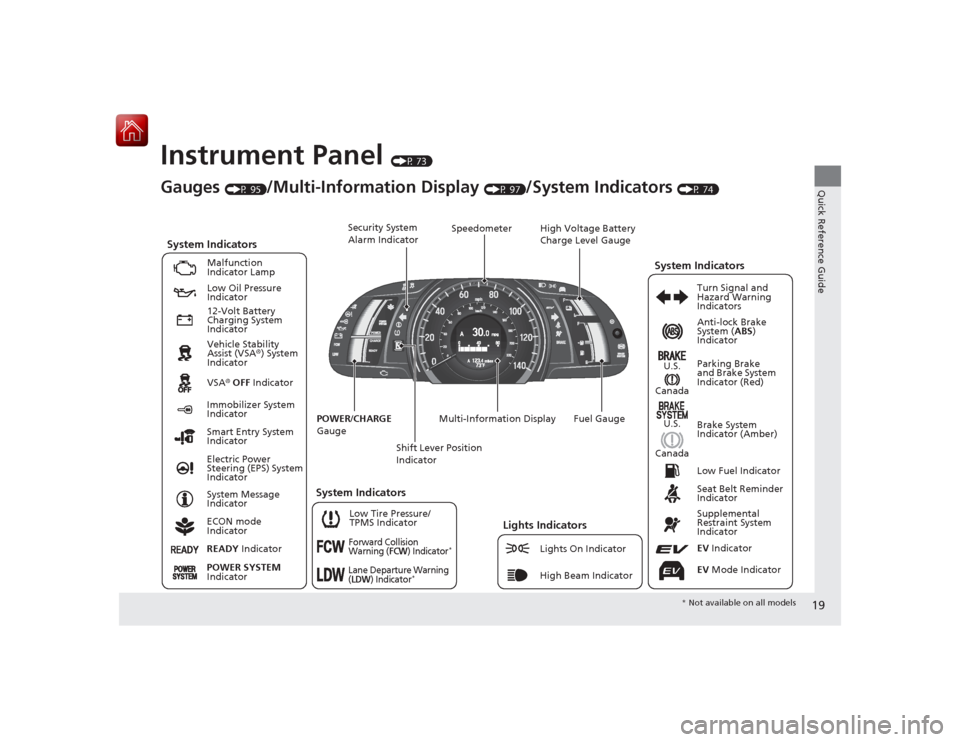
19Quick Reference Guide
Instrument Panel
(P 73)
CanadaU.S.
Low Fuel Indicator
Anti-lock Brake
System ( ABS)
Indicator
Parking Brake
and Brake System
Indicator (Red)
Canada U.S.
READY Indicator
System Indicators
Malfunction
Indicator Lamp
Low Oil Pressure
Indicator
12-Volt Battery
Charging System
Indicator
Vehicle Stability
Assist (VSA ®) System
Indicator
VSA ® OFF Indicator
Low Tire Pressure/
TPMS Indicator
Electric Power
Steering (EPS) System
Indicator
Lights Indicators
Lights On Indicator
High Beam Indicator
Immobilizer System
Indicator
Seat Belt Reminder
Indicator
EV Indicator
POWER
/CHARGE
Gauge Speedometer
Fuel Gauge
Security System
Alarm Indicator
Shift Lever Position
Indicator
Gauges
(P 95)
/Multi-Information Display
(P 97)
/System Indicators
(P 74)Turn Signal and
Hazard Warning
Indicators
System Indicators
High Voltage Battery
Charge Level Gauge
POWER SYSTEM
IndicatorSmart Entry System
Indicator
System Message
Indicator
ECON mode
Indicator
Forward Collision
Warning (
FCW
) Indicator
*
Lane Departure Warning
(LDW
) Indicator
*
Brake System
Indicator (Amber)
Supplemental
Restraint System
IndicatorEV Mode Indicator
System Indicators
Multi-Information Display
* Not available on all models
Page 27 of 569
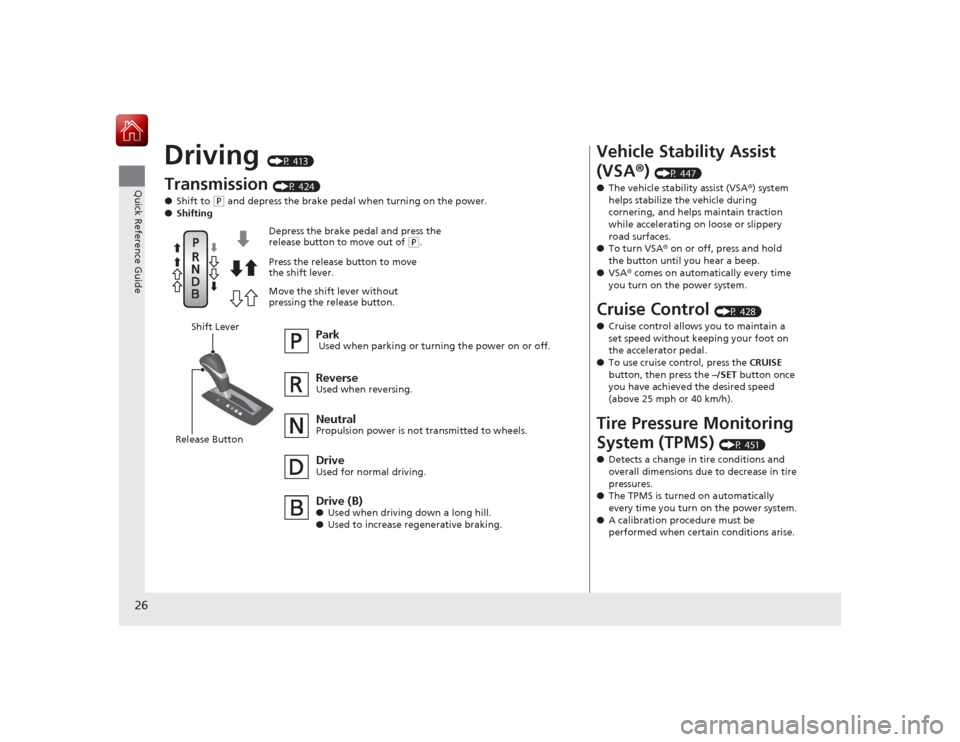
26Quick Reference Guide
Driving
(P 413)
Transmission
(P 424)
● Shift to
(P and depress the brake pedal wh en turning on the power.
● Shifting
Park Used when parking or turning the power on or off.NeutralPropulsion power is not transmitted to wheels.Drive (B)●Used when driving down a long hill.
● Used to increase regenerative braking.
Depress the brake pedal and press the
release button to move out of
(
P.
Press the release button to move
the shift lever.
Move the shift lever without
pressing the release button.
ReverseUsed when reversing.DriveUsed for normal driving.
Shift Lever
Release Button
Vehicle Stability Assist
(VSA ®)
(P 447)
● The vehicle stability assist (VSA ®) system
helps stabilize the vehicle during
cornering, and helps maintain traction
while accelerating on loose or slippery
road surfaces.
● To turn VSA ® on or off, press and hold
the button until you hear a beep.
● VSA ® comes on automatically every time
you turn on the power system.
Cruise Control
(P 428)
● Cruise control allows you to maintain a
set speed without keeping your foot on
the accelerator pedal.
● To use cruise control, press the CRUISE
button, then press the –/SET button once
you have achieved the desired speed
(above 25 mph or 40 km/h).
Tire Pressure Monitoring
System (TPMS)
(P 451)
● Detects a change in tire conditions and
overall dimensions due to decrease in tire
pressures.
● The TPMS is turned on automatically
every time you turn on the power system.
● A calibration procedure must be
performed when certain conditions arise.
Page 29 of 569
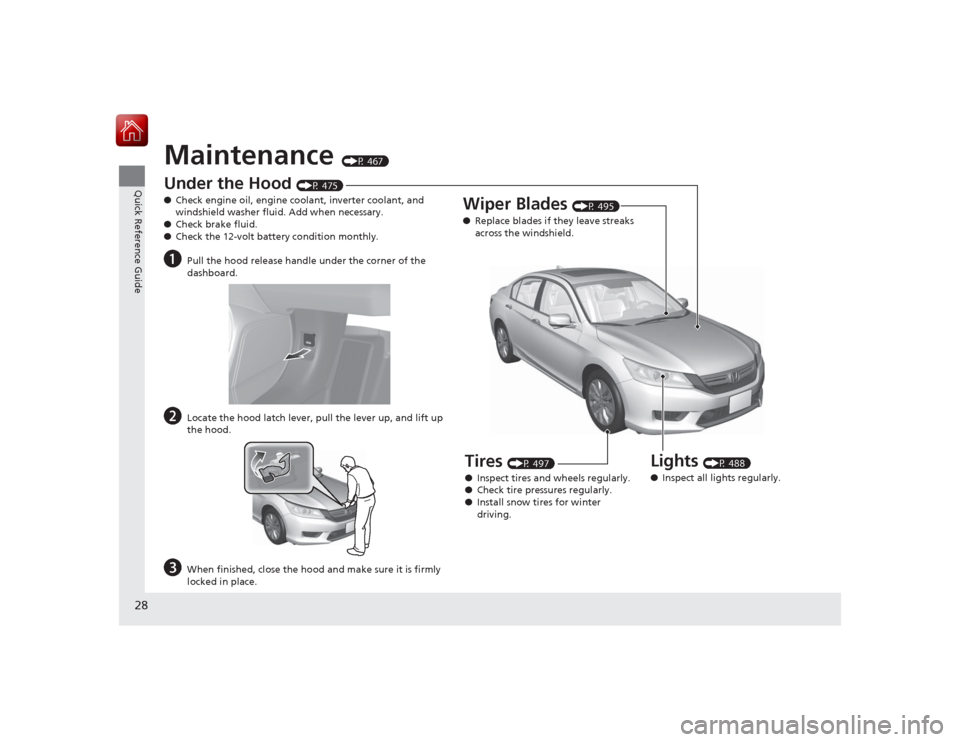
28Quick Reference Guide
Maintenance
(P 467)
Under the Hood
(P 475)
● Check engine oil, engine coolant, inverter coolant, and
windshield washer fluid. Add when necessary.
● Check brake fluid.
● Check the 12-volt battery condition monthly.
a
Pull the hood release handle under the corner of the
dashboard.
b
Locate the hood latch lever, pull the lever up, and lift up
the hood.
c
When finished, close the hood and make sure it is firmly
locked in place.
Lights
(P 488)
● Inspect all lights regularly.
Wiper Blades
(P 495)
● Replace blades if they leave streaks
across the windshield.
Tires
(P 497)
● Inspect tires and wheels regularly.
● Check tire pressures regularly.
● Install snow tires for winter
driving.
Page 36 of 569
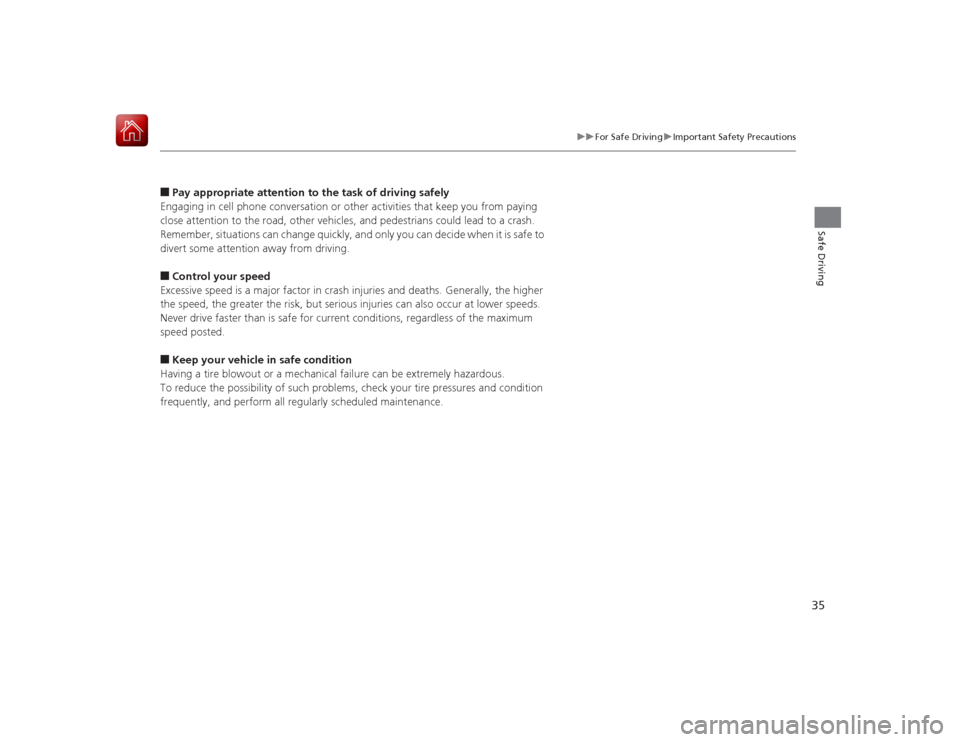
35
uuFor Safe Driving uImportant Safety Precautions
Safe Driving
■Pay appropriate attention to the task of driving safely
Engaging in cell phone conversation or other activities that keep you from paying
close attention to the road, other vehicles, and pedestrians could lead to a crash.
Remember, situations can change quickly, and only you can decide when it is safe to
divert some attention away from driving.■Control your speed
Excessive speed is a major factor in crash injuries and deaths. Generally, the higher
the speed, the greater the risk, but serious injuries can also occur at lower speeds.
Never drive faster than is safe for current conditions, regardless of the maximum
speed posted.■Keep your vehicle in safe condition
Having a tire blowout or a mechanical failure can be extremely hazardous.
To reduce the possibility of such problems, check your tire pressures and condition
frequently, and perform all regularly scheduled maintenance.
Page 81 of 569
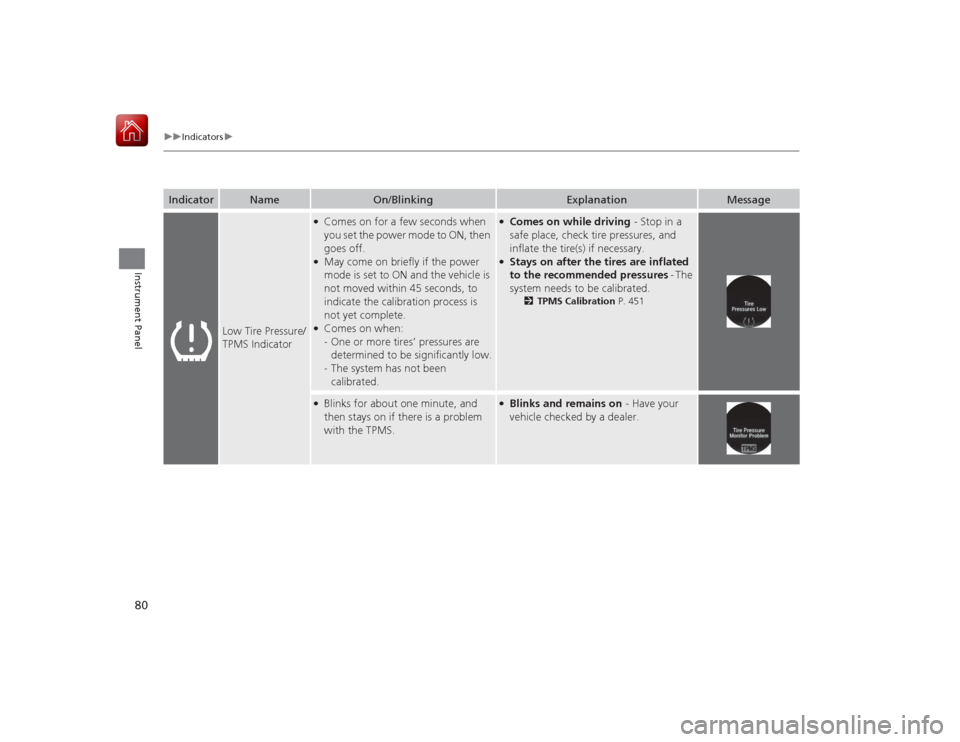
80
uuIndicators u
Instrument Panel
Indicator
Name
On/Blinking
Explanation
Message
Low Tire Pressure/
TPMS Indicator
●Comes on for a few seconds when
you set the power mode to ON, then
goes off.●May come on briefly if the power
mode is set to ON and the vehicle is
not moved within 45 seconds, to
indicate the calibration process is
not yet complete.●Comes on when:
-One or more tires’ pressures are
determined to be significantly low.
- The system has not been
calibrated.
●Comes on while driving - Stop in a
safe place, check tire pressures, and
inflate the tire(s) if necessary.●Stays on after the tires are inflated
to the recommended pressures - The
system needs to be calibrated.
2 TPMS Calibration P. 451
●Blinks for about one minute, and
then stays on if there is a problem
with the TPMS.
●Blinks and remains on - Have your
vehicle checked by a dealer.
Page 414 of 569
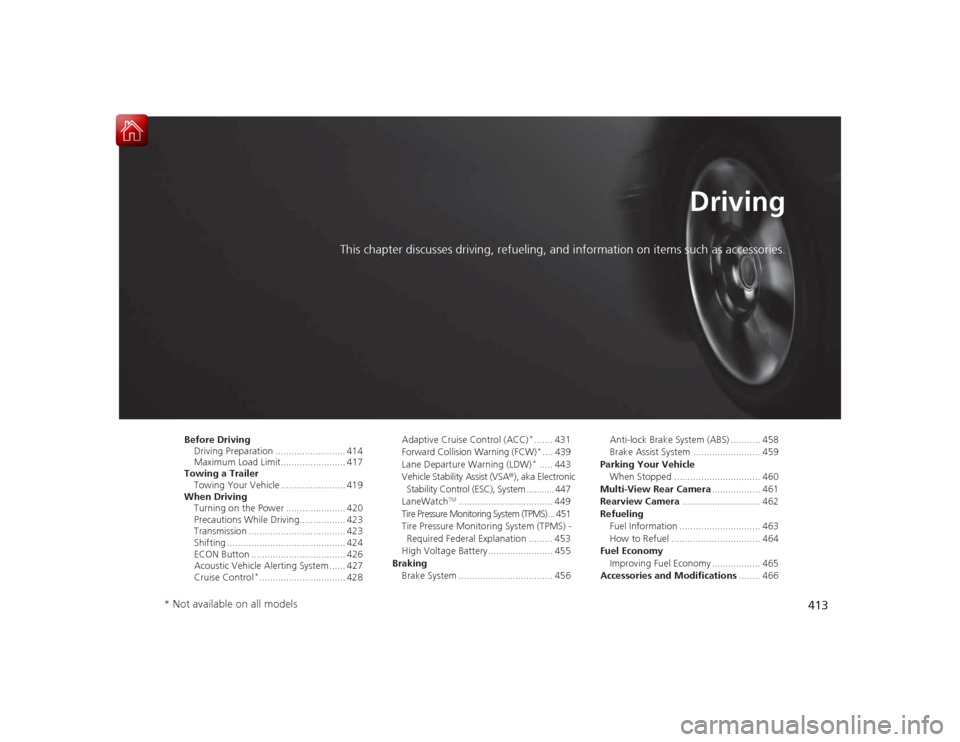
413
Driving
This chapter discusses driving, refueling, and information on items such as accessories.
Before DrivingDriving Preparation .......................... 414
Maximum Load Limit........................ 417
Towing a Trailer
Towing Your Vehicle ........................ 419
When Driving Turning on the Power ...................... 420
Precautions While Driving................. 423
Transmission .................................... 423
Shifting ............................................ 424
ECON Button ................................... 426
Acoustic Vehicle Alerting System ...... 427
Cruise Control
*................................ 428 Adaptive Cruise Control (ACC)
*....... 431
Forward Collision Warning (FCW)*.... 439
Lane Departure Warning (LDW)*..... 443
Vehicle Stability Assist (VSA® ), aka Electronic
Stability Control (ESC), System ........... 447
LaneWatch
TM................................... 449
Tire Pressure Monitoring System (TPMS) ... 451
Tire Pressure Monitoring System (TPMS) - Required Federal Explanation ......... 453
High Voltage Battery ........................ 455
Braking Brake System ................................... 456 Anti-lock Brake System (ABS) ........... 458
Brake Assist System ......................... 459
Parking Your Vehicle When Stopped ................................ 460
Multi-View Rear Camera .................. 461
Rearview Camera ............................. 462
Refueling Fuel Information .............................. 463
How to Refuel ................................. 464
Fuel Economy Improving Fuel Economy .................. 465
Accessories and Modifications ........ 466
* Not available on all models
Page 415 of 569
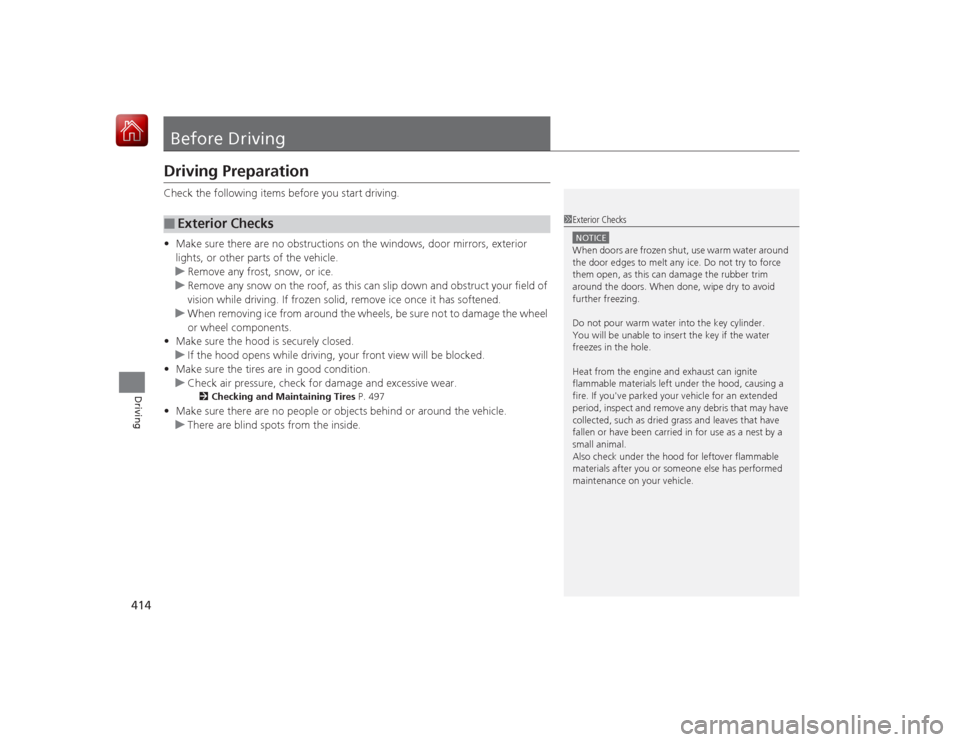
414Driving
Before DrivingDriving PreparationCheck the following items before you start driving.
•Make sure there are no obstructions on the windows, door mirrors, exterior
lights, or other parts of the vehicle.
u Remove any frost, snow, or ice.
u Remove any snow on the roof, as this can slip down and obstruct your field of
vision while driving. If frozen solid, remove ice once it has softened.
u When removing ice from around the wheels, be sure not to damage the wheel
or wheel components.
• Make sure the hood is securely closed.
u If the hood opens while driving, your front view will be blocked.
• Make sure the tires are in good condition.
u Check air pressure, check for damage and excessive wear.
2 Checking and Maintaining Tires P. 497
•Make sure there are no people or objects behind or around the vehicle.
u There are blind spots from the inside.■
Exterior Checks
1Exterior ChecksNOTICEWhen doors are frozen shut, use warm water around
the door edges to melt any ice. Do not try to force
them open, as this can damage the rubber trim
around the doors. When done, wipe dry to avoid
further freezing.
Do not pour warm water into the key cylinder.
You will be unable to inse rt the key if the water
freezes in the hole.
Heat from the engine and exhaust can ignite
flammable materials left under the hood, causing a
fire. If you've parked your vehicle for an extended
period, inspect and remove any debris that may have
collected, such as dried grass and leaves that have
fallen or have been carried in for use as a nest by a
small animal.
Also check under the hood for leftover flammable
materials after you or someone else has performed
maintenance on your vehicle.
Page 448 of 569

447
uuWhen Driving uVehicle Stability Assist (VSA® ), aka Electronic Stability Control (ESC), System
Continued
Driving
Vehicle Stability Assist (VSA®), aka Electronic Stability Control (ESC), SystemHelps to stabilize the vehicle during cornering if the vehicle turns more or less than
what was intended. It also assists in maintaining traction on slippery surfaces. It does
so by regulating motor output and selectively applying the brakes.
When VSA® activates, you may notice that the
motor does not respond to the accelerator.
You may also notice some noise from the
hydraulic system. You will also see the
indicator blink.■
VSA ® Operation
1 Vehicle Stability Assist (VSA ®), aka Electronic Stability Control (ESC), System
VSA ® may not function properly if tire type and size
are mixed. Make sure to use the same size and type
of tire, and the air pressures as specified.
When the VSA ® indicator comes on and stays on
while driving, there may be a problem with the
system. While this may not interfere with normal
driving, have your vehicle checked by a dealer
immediately.
VSA ® cannot enhance stability in all driving situations
and does not control the entire braking system. You
still need to drive and cor ner at speeds appropriate
for the conditions and always leave a sufficient
margin of safety.
The main function of the VSA ® system is generally
known as Electronic Stability Control (ESC). The
system also includes a traction control function.
VSA ® System
Indicator
Page 452 of 569
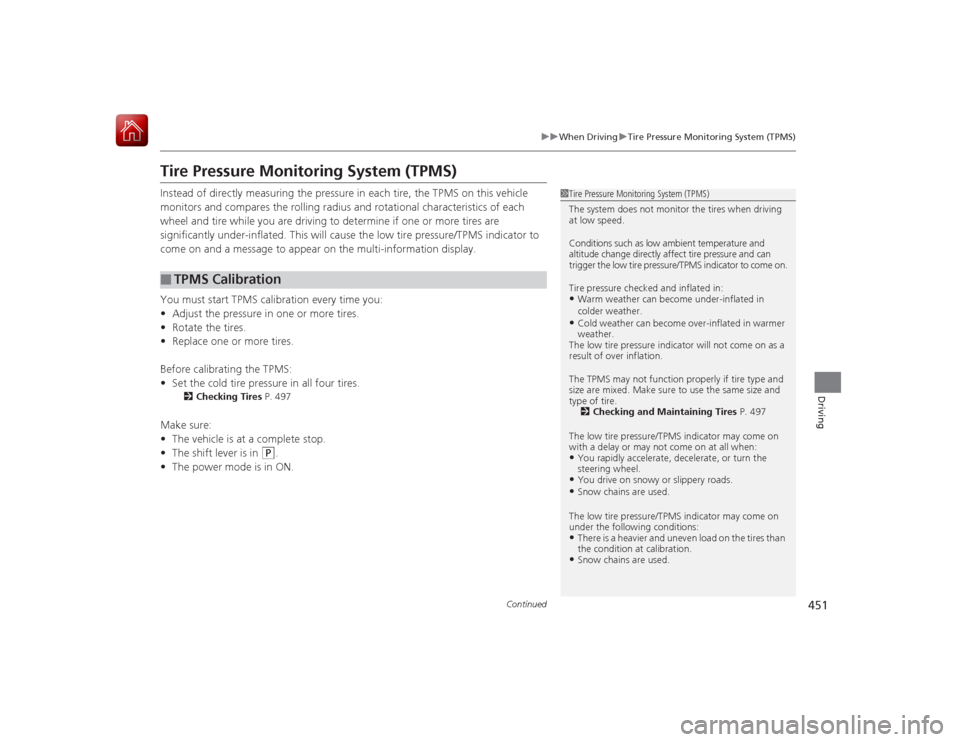
451
uuWhen Driving uTire Pressure Monitoring System (TPMS)
Continued
Driving
Tire Pressure Monitoring System (TPMS)Instead of directly measuring the pressure in each tire, the TPMS on this vehicle
monitors and compares the rolling radius and rotational characteristics of each
wheel and tire while you are driving to determine if one or more tires are
significantly under-inflated. This will cause th e low tire pressure/TPMS indicator to
come on and a message to appear on the multi-information display.
You must start TPMS calibration every time you:
• Adjust the pressure in one or more tires.
• Rotate the tires.
• Replace one or more tires.
Before calibrating the TPMS:
• Set the cold tire pressure in all four tires.
2 Checking Tires P. 497
Make sure:
•The vehicle is at a complete stop.
• The shift lever is in
(P
.
• The power mode is in ON.
■
TPMS Calibration
1Tire Pressure Monitoring System (TPMS)
The system does not monitor the tires when driving
at low speed.
Conditions such as low ambient temperature and
altitude change directly affect tire pressure and can
trigger the low tire pressure/TPMS indicator to come on.
Tire pressure checked and inflated in:•Warm weather can become under-inflated in
colder weather.•Cold weather can become over-inflated in warmer
weather.
The low tire pressure i ndicator will not come on as a
result of over inflation.
The TPMS may not function properly if tire type and
size are mixed. Make sure to use the same size and
type of tire. 2 Checking and Maintaining Tires P. 497
The low tire pressure/TP MS indicator may come on
with a delay or may not come on at all when:•You rapidly accele rate, decelerate, or turn the
steering wheel.•You drive on snowy or slippery roads.•Snow chains are used.
The low tire pressure/TP MS indicator may come on
under the following conditions:•There is a heavier and uneven load on the tires than
the condition at calibration.•Snow chains are used.
Page 453 of 569

uuWhen Driving uTire Pressure Monitoring System (TPMS)
452Driving
You can calibrate the system from the
customized features on the multi-information
display.
1. Press the / button to select Vehicle
Settings , then press the SEL/RESET button.
u TPMS Calibration appears on the display.
2. Press the SEL/RESET button.
u The display switches to the
customization setup screen, where you
can select Cancel or Calibrate .
3. Press the / button and select
Calibrate , then press the SEL/RESET button.
u Calibration Started screen appears,
then the display returns to the
customization menu screen.
• If the Calibration Failed to Start message
appears, repeat steps 2-3.
• The calibration process finishes
automatically.
1TPMS Calibration•The calibration process requires approximately 30
minutes of cumulative driving at speeds between
30-60 mph (48-97 km/h).•During this period, if the po wer mode is set to ON
and the vehicle is not moved within 45 seconds,
you may notice the low tire pressure indicator
comes on briefly. This is normal and indicates that
the calibration process is not yet complete.
You can cali brate the system using the audio/
information screen.
2 Customized Features P. 297
If the snow chains are installed, remove them before
calibrating the TPMS.
If the low tire pressure/TPMS indicator comes on even
when the properly inflated specified regular tires are
installed, have your vehicle checked by a dealer.
We recommend that the tires be replaced with the
same brand, model, and size as the originals. Ask a
dealer for details.
44